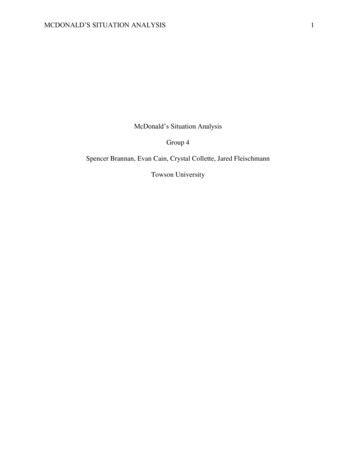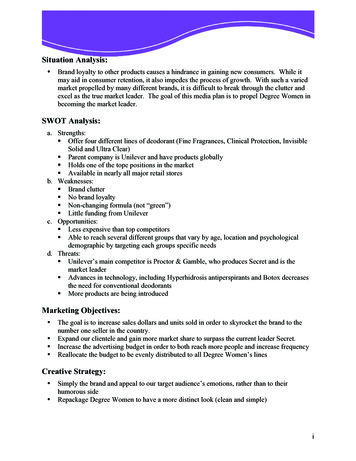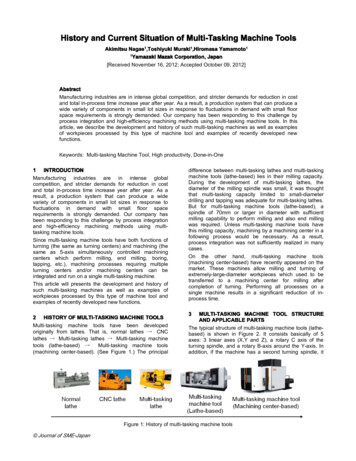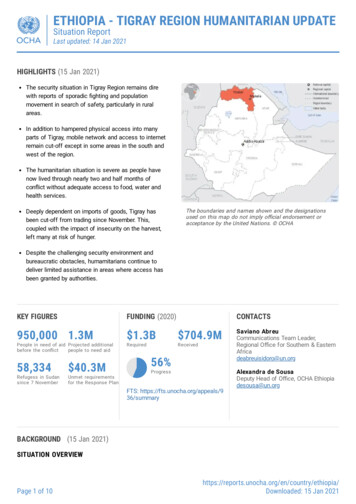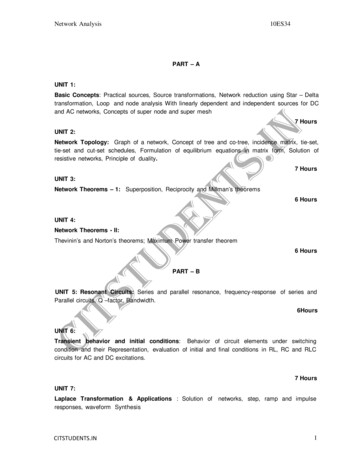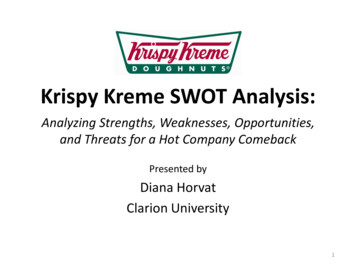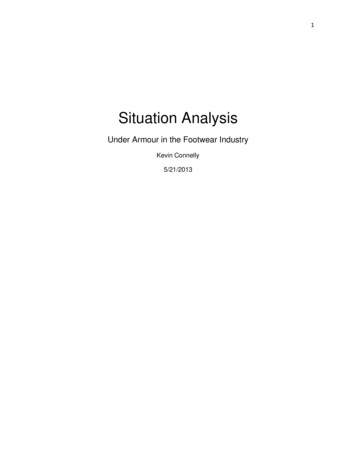
Transcription
1Situation AnalysisUnder Armour in the Footwear IndustryKevin Connelly5/21/2013
2Under Armour in the Footwear IndustryIn this report, I will be analyzing Under Armour’s position in the athletic footwear industry. The issue Ihave found to be apparent is that Under Armour faces a limited range of authority in the footwear market.Under Armour first entered the athletic footwear industry in 2006 and since then has only been able tocapture less than 1% market share. The following report will include findings from a company andindustry analysis; competitive and SWOT analysis; and market analysis; as well as a thorough listing ofrecommendations based on these analyses.Company and Industry AnalysisUnder Armour makes up a very small portion of the athletic footwear industry, but its footwear sales aregrowing rapidly year to year. Even so, the sales figures show that Under Armour is in a poor position inthe athletic footwear industry. The following company and industry analysis will give us a clearer pictureof where Under Armour stands in relation to the rest of the industry.Under Armour Grows Faster Than the IndustryUnder Armour has been experiencing major growth in footwear sales since the launch of its footwear linein 2006. According to Under Armour financial statements, in 2010 Under Armour had total footwearsales of 127,175. In 2011, its total footwear sales reached 181, 684. Reported most recently, for fiscal2012, total footwear sales increased to 238,955 (Under Armour Annual Report, 2012, p. 73). That is a42.9% increase from 2010 to 2011. In contrast, according to sales figures reported by the NationalSporting Goods Association, sales for the athletic footwear industry as a whole increased by only 5.2% inthat same year (SBRnet, 2012). This means that Under Armour’s footwear sales are growing at a fasterrate than sales for the industry as a whole. However, if we compare Under Armour’s sales to othercompanies in the industry, we can see that Under Armour still has a long way to go to become a topfootwear competitor.Under Armour Falls Far Behind CompetitionTable 1 below shows annual footwear sales for Under Armour and three of its close competitors.Table 1. Industry Footwear SalesUnder ArmourNikeAdidasAsics2010127,17510.3 billion5.39 billion2011181,68411.52 billion6 billion2012238,95513.42 billion6.92 billion1.79 billionNote. Sales data. Adapted from Under Armour, Nike, Adidas, and Asics financial reports.Nike has been a major company and brand in the footwear, as well at athletic, industry for decades. Dueto their longstanding presence in the footwear industry, Nike has continually had increasing sales in thefootwear segment. As seen through this data, Nike is continually profitable in the footwear industry. It has
3been making revenue in the billions which is significantly higher than Under Armour has yet to produce(Nike Inc., 2012).Adidas is another key competitor in the footwear industry whose sales are coveted. It has developed apresence in the footwear industry for creating products that have been used by a variety of customersfrom different socioeconomic standings. While Adidas does have lower amounts than Nike, Adidas ismaking profits that widely surpass those of Under Armour. (Adidas Group., 2012).Asics has been continually making profits that are less than the top firms in the footwear industry.However, its income from footwear sales is still greater than that of Under Armour (Asics Corporation.,2012).Limited Product LineAnother factor we should look at as we try to understand why Under Armour’s sales aren’t stacking upwith the rest of the industry is what footwear products is Under Armour offering? Compared to the rest ofthe industry under Armour has a relatively limited product line. While brands like Nike and Adidas offerover 100 different styles of men’s shoes, Under Armour has less than 40. These include football, baseball,soccer, and lacrosse cleats; as well as basketball and running shoes. Under Armour’s women’s shoe line iseven more limited offering only running shoes and softball cleats. As you may notice, Under Armour’sfootwear products are geared mainly toward the male athlete. So there is a large portion of the athleticfootwear market that it is not reaching.Too Much Emphasis on PerformanceIn addition to a limited product line, Under Armour shoe sales have been plagued by the very factorwhich had spawned its success: performance. In choosing to focus solely on increasing the speed, agility,and total athletic performance for the consumer, Under Armour has neglected the fashion aspect offootwear. It is true that market niche specialization is critical in creating a unique and recognizable brand.However, if Under Armour truly wants to increase footwear sales, it must shift attention to adding morestyle to its footwear.To expand on this even further, let us begin by identifying the mission of Under Armour: to make allathletes better though passion, design, and the relentless pursuit of innovation (“Under Armour InvestorRelations,” 2006). The most obvious thought that comes to mind after reading this statement is that thisbrand was made solely for the athlete. The words “passion” and “relentless” match perfectly with thetraits of a superstar sports figure. Therefore, it is obvious that Under Armour is targeting the everydayathlete in its business model. However, in choosing to target mostly athletes, Under Armour hasunintentionally limited profitability and market potential. Under Armour has become one-dimensionaldue to the limited focus on non-athletes, and inability to incorporate fashion into its footwear lines.A few years ago, Nike launched a new product line called Presto. Presto was intended to bridge the gapbetween sports and fashion (“Hargrave-Silk,” 2003). In 2003, Nike added Converse to its line offootwear products. These strategic marketing and management decisions have been directed at adding anextra element to an already successful sports brand. Whereas Nike and other footwear companies in theindustry have sought to appeal to both the performance and fashion aspects of footwear, Under Armourhas reduced itself to only the athletic segment. In doing so, Under Armour has substantially reduced thesize of its market, and ability to maximize growth potential.
4Core Competencies Reinforce Fashion WeaknessKevin Plank, the CEO and Founder of Under Armour has expressed what he believes to be the three mostimportant core competencies of his company: powerful brand identity, product performance, andcustomer satisfaction (“Prospectus Summary,” 2005). In each competency, Plank emphasized theimportance of using innovative technology to produce a high-quality performance product. If Plank isserious about attaining overall customer satisfaction, he must first amend the core strengths that createdhis success. He must continue producing performance products, but also add a degree of style to hisbrand.Research and DevelopmentThis section of the report describes the research and development conducted for the analysis of UnderArmour and the footwear industry as a whole. Under Armour competes in a competitive market to gain anedge over the competition. The following headings describe the factors involved in Under Armour’sResearch and Development.Brand Loyalty In the Footwear Market. In the United States, there are four major shoe brands in thefootwear industry: Nike, Adidas, Asics, and Under Armour. For years, Nike has been the most productivefootwear company holding 15 of the top 17 best basketball shoes for the year 2012 (The Best BasketballShoes, 2012). This is a staggering number, but for such a large company, brand loyalty plays a major roleas well. Nike has been around since 1964 (originally called, Blue Ribbon Sports before changing theirname to, Nike), Adidas since 1949, and Asics since 1949 as well (originally called, Onitsuka Co., Ltd).Under Armour started in 1996 and didn’t become a household name until 2003 when it came out with itsfirst commercial (Nike Adidas Asics, 2013). Despite Under Armour’s recent success in the past fewyears, surpassing powerhouse footwear companies such as Nike, Adidas, or Asics will be a majorchallenge in their respective industry.Endorsement Wars. Under Armour currently has endorsed 25 athletes, notably: Michael Phelps, RayLewis, and Bryce Harper (Under Armour Endorsers, 2013). In the footwear market today, signing apopular athlete to your company can be the difference in making revenue during the upcoming fiscal year,or having extreme expenses. Nike is the leader in the industry again with 48 confirmed endorsed athletes,but this is excluding endorsements with professional sports teams and leagues (in 2012, the NFL signedan endorsement deal with Nike) (Nike Endorsers, 2013). Under Armour runs as a mediocre company withendorsements, but they lack one thing: more than one model of a shoe to show for athletes to wear andmarket. This leads me to my next sub point, Spine.Under Armour’s Spine Model. Spine is Under Armour’s most popular shoe, released in 2012 by shoedesigner, Dave Dombrow (Under Armour Unveils New UA Spine, 2012). The idea for the shoe camefrom a model of the actual human spine with the flexibility as well as strength as the core ideas for theshoe. The idea of the shoe was for it to be agile when it needs to be, but rigid when it must be. Despite theingenuity of the shoe, Under Armour lacks the style that other companies in the industry have shown inour company sales. Comfort and protection have been accomplished in the Spine shoe, but style is still anongoing effort to perfect.Bottom Line. In conclusion for research and development, Under Armour still lacks in the category ofthe footwear industry. Between brand loyalty, endorsing big name athletes, and lack of style, Under
5Armour is still far away from gaining a competitive advantage on any big name companies (Nike, Adidas,Asics) in the This brings me to my closing statement about Under Armour within the footwear industry.Under Armour Must Catch Up With IndustryWe would like to conclude the company and industry portion of this analysis by pointing out that this is acompany specific issue rather than an industry wide issue. We know this because the industry is growingas a whole and Under Armour’s competitors have been very successful. In the next section, we will betaking a closer look at these competitors in a competitive and SWOT analysis to see what these successfulshoe brands are doing in regards to footwear and how those strategies might be applied to Under Amrour.Competitive AnalysisIn this portion of our report I will conduct an analysis of two major competitors, Nike and Adidas, in thefootwear market. Based on sales, product lines, and endorsements of these two companies compared toUnder Armour, Under Armour is in a relatively poor position in the footwear market.Nike Footwear Sales Mark Nike as the Leader in Footwear.Nike sales have been a major indicator of their success in the footwear industry labeling themselves as thetop competitor. Nike has been a top brand in the footwear industry for decades which is reflected throughtheir sales figures. According to the financial records of Nike Financial Group, Nike sales havecontinually climbed year after year. In 2010, Nike reached sales of 10.3 billion. In 2011, Nike reachedfootwear sales of 11.52. And in the most recent financial period of 2012, Nike has amassed footwearsales of 13.42 billion (Nike, Inc., 2012). As seen through this data, Nike is experiencing persistentgrowth in their footwear sales. This continual growth is also reflected in the percentage of footwear salesto total sales of Nike. Nike financial records also indicate footwear sales generate around 69% of sales inthe entire Nike brand (Nike, Inc., 2012). This percentage is the largest component of all the salescategories in Nike which include apparel and accessories (Under Armour, Inc., 2012).Nike Product LineNike currently offers over 550 styles of men’s shoes and almost 300 different styles of women’s shoes(nike.com). Product categories include those also offered by Under Armour (running, training, football,basketball, soccer, lacrosse, baseball, softball) as well as golf, skateboarding, tennis, and wrestling shoes.Nike also has a line of lifestyle shoes which are just simply for everyday wear and not related to anyspecific sport or activity. Something else that sets Nike apart from Under Armour is something called“Nike iD” where customers can customize everything from the style of their shoe to the material and eventhe color of the stitching and shoe laces.Nike EndorsementsNike as a company has stores in 42 different countries as well as Africa and the Middle East (Nike, 2013).This shows their connection to the different countries and cultures of the world as well as their expansionsince they first started as a company in 1964 (Nike Repository, 2010). Under Armour began in 1995 in
6Baltimore, MD and as an athletic apparel company (Under Armour, 2013). Breaking into the footwearindustry has proven as not an easy task based on the sales from the past three years and for a good reason:Nike endorses non-athletes. Nike currently endorses Kanye West, the boys of the MTV reality showJersey Shore, and even the current President of the United States, Barack Obama as well as many of thebest athletes in the world such as Tiger Woods and LeBron James. Under Armour has athletes such asBryce Harper, Lindsey Vonn, and Michael Phelps although no non-athletes. There a few reasons for thissuch as loyalty, image, and music that have been preventing Under Armour from being a competitivecompany measured against Nike.Nike Brand LoyaltyNike has been around for 31 years longer than Under Armour has. This number represents the oldergenerations that have grown up with Nike as one of the main brands of shoes to wear. Breaking into theshoe industry is not easy, especially when you start up as an athlet
In this report, I will be analyzing Under Armour’s position in the athletic footwear industry. The issue I have found to be apparent is that Under Armour faces a limited range of authority in the footwear market. Under Armour first entered the athletic footwear industry in 2006 and since then has only been able to capture less than 1% market share. The following report will include findings from a company and
